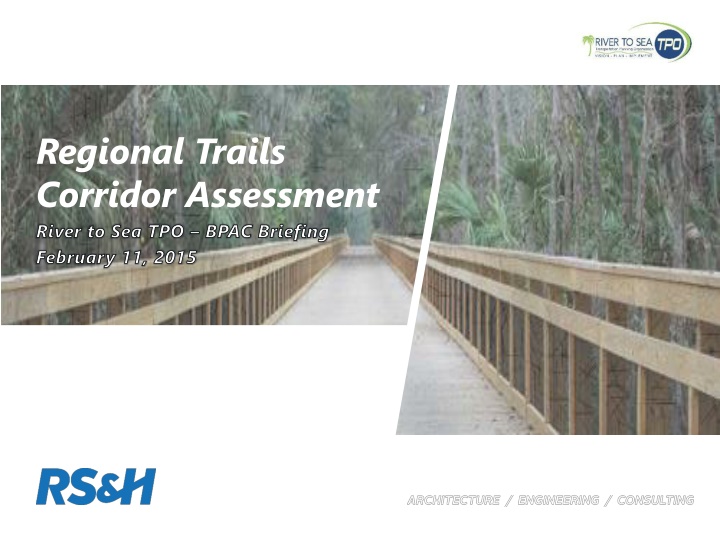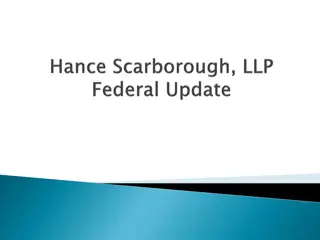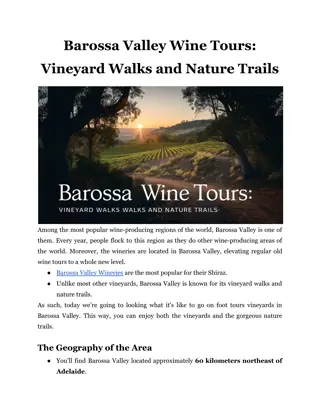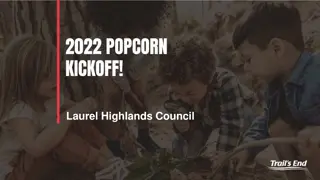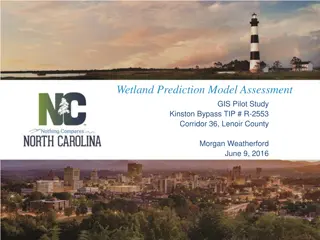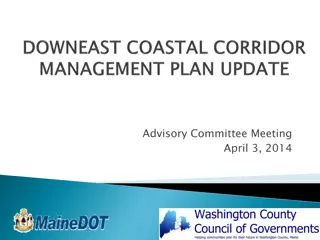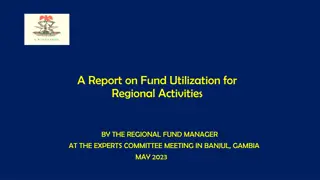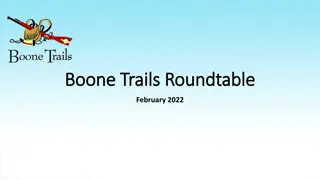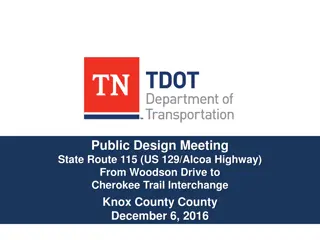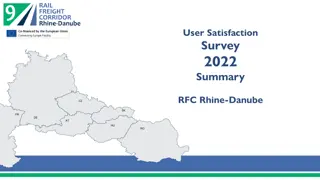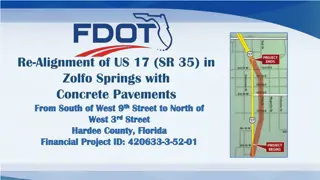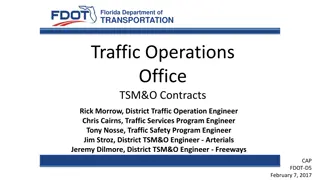Regional Trails Corridor Assessment Project Overview
The Regional Trails Corridor Assessment project aims to complete the trail network in the TPO Planning Area and enhance the Florida Greenways and Trails System. The project involves identifying existing trail gaps, developing alignments, and estimating costs to secure funding. Progress updates include stakeholder meetings, data collection, and draft study presentations. Guidelines for regional trail widths are also outlined based on national and state trail manuals.
Uploaded on Nov 24, 2024 | 0 Views
Download Presentation

Please find below an Image/Link to download the presentation.
The content on the website is provided AS IS for your information and personal use only. It may not be sold, licensed, or shared on other websites without obtaining consent from the author.If you encounter any issues during the download, it is possible that the publisher has removed the file from their server.
You are allowed to download the files provided on this website for personal or commercial use, subject to the condition that they are used lawfully. All files are the property of their respective owners.
The content on the website is provided AS IS for your information and personal use only. It may not be sold, licensed, or shared on other websites without obtaining consent from the author.
E N D
Presentation Transcript
Regional Trails Corridor Assessment River to Sea TPO BPAC Briefing February 11, 2015
Project Goals Complete the regional trails network in the TPO Planning Area and advance the Florida Greenways and Trails System Plan by developing/finalizing alignments and connections. Understand/inventory where there are existing trail gaps and determine the feasibility of alignments. Complete assessments and develop conceptual plans and cost estimates for all gap segments in order to compete for funding. Trail improvements will NOT be prioritized as a part of this study. 2
Project Progress Overview September 29, 2014 23 Attendees Introduced Study and Obtained Input November 19-20, 2014 Eight (8) field review meetings Visited Potential Gap Locations Concept / Cost Development and Documentation Stakeholder Meeting #1 Small Group Workshops Field Reviews Data Stakeholder Meeting #2 Collection October 29-30, 2014 Detailed Review of Trail Segments Four (4) Interactive Workshops Aug-Nov 2014 December 17, 2014 26 Attendees Presented Draft Study Findings
Inventory of Regional Trails Existing Trails Planned / Programmed Trails Gaps and Proposed Alignments 5
Regional Trail Widths Guidelines Excerpts from National and State Trail Guidelines and Manuals FDOT Manual on Uniform Traffic Control Devices (MUTCD) (known as the Florida Greenbook) 2011 (Shared Use Path) FDOT Plans Preparation Manual, 2012 (Design Guidance for Shared Use Paths) 8.6.2 Widths American Association of State Highway and Transportation Officials (AASHTO), Guide for the Development of Bicycle Facilities, 2012 4th edition (Shared Use Paths) FHWA, Manual on Uniform Traffic Control Devices Source: Best Practices Design Guide Typically, widths range from 10-14 feet The minimum width for a two- directional shared use path is 10 feet. The tread of a shared-use path should be at least 10 ft. wide. A minimum of 8 ft may be used on shared- use paths that will have limited use. On shared-use paths with heavy volumes of users, tread width should be increased to a range from 12 to 14 ft. The minimum paved width for a two-directional shared use path is 10 ft Typically, widths range from 10 to 14 ft. A path width of 8 ft may be used for a short distance Eleven (11) foot pathways are needed to enable a bicyclist to pass another path user going the same direction. The minimum recommended width for a paved two-way path is 10 feet. In many cases, it is desirable to increase the minimum width to 12 feet. In limited cases, 8 feet may be acceptable. 6
Planned/Programmed Trails Work Programs TIP State and Local Projects Studies 8
Gaps and Proposed Alignments Resolutions Master Plans Regional Corridor Alignments Field Review Stakeholder Input 9
Connectors / Potential Trails of Regional Significance Regional Trails Existing Facilities by Width Connector Trails Existing Connectors Existing Connector Existing: 12 feet or greater Recommended Connectors Existing: 10 feet to less than 12 feet Recommended by Stakeholders Trail Existing: 8 feet to less than 10 feet Recommended by Stakeholders Multi-use Path / Sidewalk Existing: Less than 8 feet Planned / Funded Funded: Construction Funded: Design 10 Funded: PE/Study Proposed Alignment Proposed: Per Adopted Document Proposed: Stakeholder Input
Trail Gap Matrix (1 of 2) Trail Gap Segment ID Regional Trail(s) Length (miles) Jurisdiction Road Name(s) Segment Start Segment End Recommended Next Steps Conduct feasibility study subsequent to completion of City s parking study Conduct feasibility study for bike lanes along Halifax Drive and Standish Drive Complete concept design for gap City of Flagler Beach N. 9th Street S 26th Street A1A ECG, SJR 2.9 A City of Ormond Beach East Grenada Boulevard A1A ECG, SJR Standish Drive 1.5 B City of Daytona Beach Marina Point Drive Bellevue Avenue Beach Street ECG, SJR 0.7 C Carmen Drive and Reed Canal Road W. Park Ave, Mango Tree Dr., 16th St., Hibiscus Dr., Roberts Road W. Minnesota Ave, S. Grand Ave, S. Beresford City of South Daytona Ridge Boulevard at Carmen Drive Reed Canal Road at US 1 Complete concept design for gap ECG, SJR 1.2 D East Central Regional Rail Trail (ECRRT) terminus at Dale Street Complete feasibility study of southbound ECCRT connection through Edgewater City of Edgewater ECG, SJR Roberts Road 4.5 E W. Beresford Rd to terminus of Alexander Dr. Volusia County (West of DeLand) S2S, SJR, ECG-A, HoF Complete concept design for gap Beresford Park 2.9 F 12
Trail Gap Matrix (2 of 2) Trail Gap Segment ID Regional Trail(s) Length (miles) Jurisdiction Road Name(s) Segment Start Segment End Recommended Next Steps Subsequent to County s construction of five foot bike lanes and five foot sidewalks in both directions, continue to monitor community support for potential construction of a regional trail with a standard width Complete feasibility study for crossings at Baxter Street and US 17 and trail connecting from McGinnis Elementary School to Grand Ave Complete concept design for gap Volusia County (West of DeLand) Grand Avenue S2S, SJR, ECG-A, HoF Lemon Street King Street 1.7 G US 17 / Baxter Street McGinnis Elementary School Baxter Street at Grand Avenue Volusia County (DeLeon Springs) S2S, SJR, ECG-A, HoF 0.1 H Putnam County Line Volusia County SR 17 SJR, ECG-A SR 40 13.7 I Volusia County (West of Ormond Beach) Florida Black Bear Scenic Trail Complete concept design for gap SR 40 Cone Road Airport Road 2.2 J 13
Project Deliverables GIS / KMZ files General Concept Plans and Cost Estimates for Gaps Final Report Data Inventory Methodology Identification of Challenges and Opportunities February/March 2015 14
NEXT STEPS Present to R2CTPO CAC, TCC and Board February 17th and 25th Complete Final Report / GIS Map Early March 2015 Study Adoption March 2015 Concept / Cost Development and Final Report / GIS Data Stakeholder Check In #1 Small Group Workshops Stakeholder Check In #2 Field Reviews Collection March 2015 15
Project Contacts Consultant Contacts: Steve Cote, PE, AICP (Project Manager) steve.cote@rsandh.com, 678-528-7220 Ginger Hoke, RLA ginger@hokedesign.com, 407-923-6027 R2CTPO: Jean Parlow (Project Manager) jparlow@r2ctpo.org, 386-226-0422, ext. 20417 Stephan Harris (Bicycle/Pedestrian Coordinator) sharris@r2ctpo.org, 386-226-0422, ext. 20428 16
